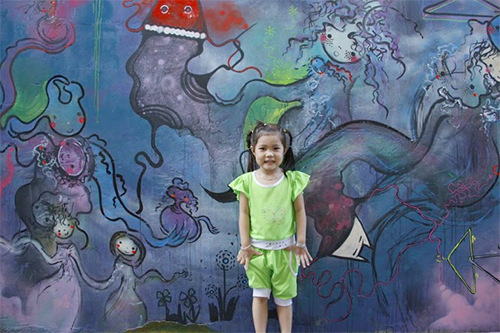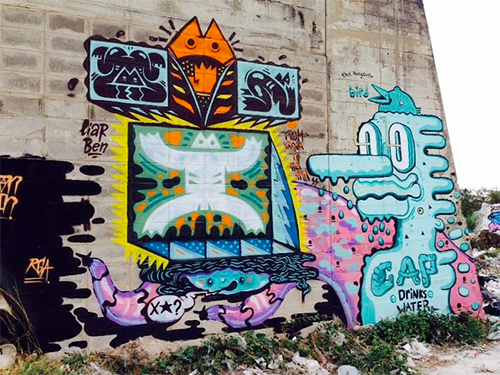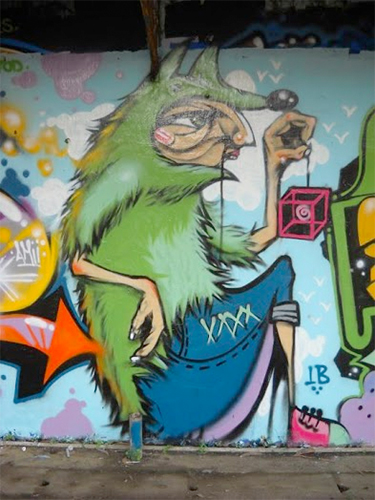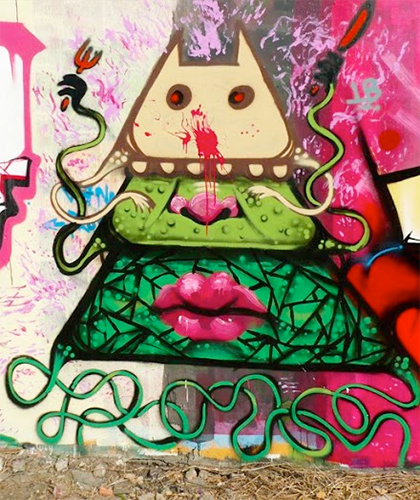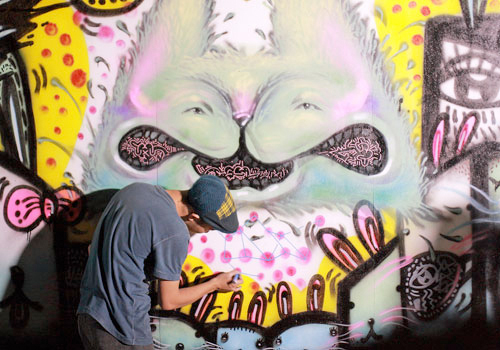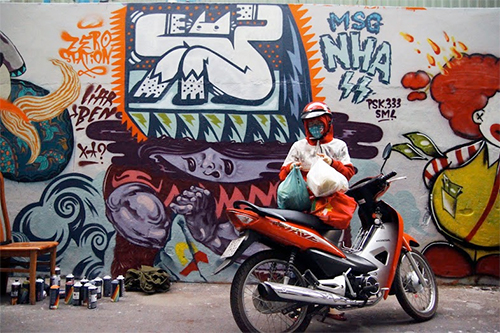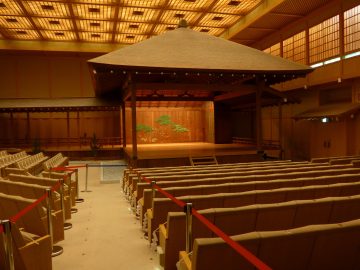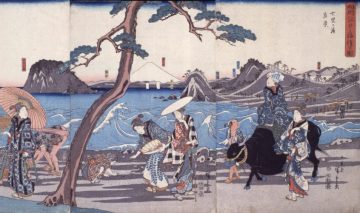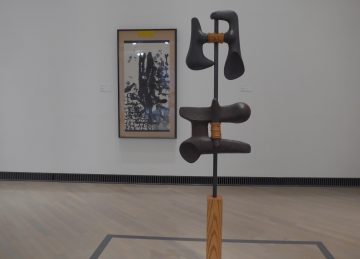An interview with Ryer Ben, an artist featured at the Koganecho Bazaar
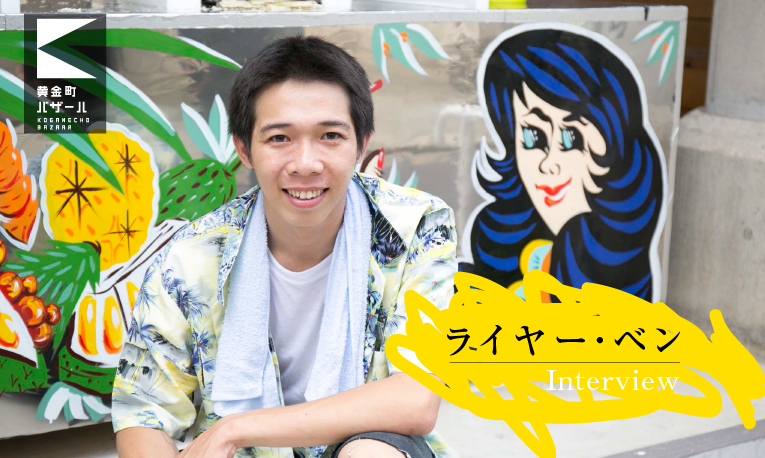
Interview & text: Akiko Inoue photo: Masamasa Nishino
Layar Veng, a participating artist at Koganecho Bazaar 2014, is a Vietnamese artist who creates murals with spray cans, video and computer design works, character creation, etc. This time, an ongoing project was being introduced, so I visited 1-1 Studio, which had just opened in early August and where his work was on display.
Sugarcane juice stalls are a common sight when traveling in Southeast Asia. The project he is developing in Koganecho this time is the "Sugarcane Lady Project", which was inspired by a painting of a woman that was once on one of these stalls. Based on fieldwork and research, this project is an attempt to explore the historical and cultural background hidden behind the character that could be described as the national female image through people's personal memories.
Ben, who leaves an impression with his carefree smile and easygoing demeanor, despite his journalistic curiosity in collecting small memories drowned out by the noise of history, spoke to us about his project.
What is the Sugarcane Lady Project?
- First, before I ask you about the project, I would like to ask you about the current situation surrounding sugarcane juice in Vietnam.
Are sugarcane juice stalls common throughout Vietnam? And do they all have pictures of sugarcane ladies on them?
Sugarcane juice stands in Vietnam changed from a style where actual women stood selling juice to a style where pictures of women were painted on the stands when the war (Vietnam War) ended in 1975. This is because the concept of advertising was brought to Vietnam under the influence of the United States, and after that, flashy motifs such as fruits and sugar cane, like the Sugarcane Ladies, began to be incorporated into the stands.
However, in today's Vietnam, these old-fashioned food stalls are rarely seen, and now it is more common for sales to be done using automatic machines.
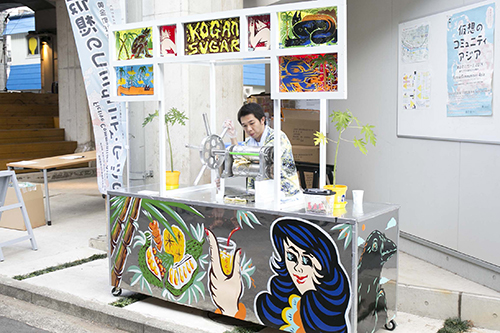
Kogai-Sugar Cane Super Machine by Ryah Ben
- So where did you first discover this painting, Ben? Tell us what prompted you to start the "Sugarcane Lady Project."
I don't remember where I first found it, but I found it when I went to the countryside. There are still many old-fashioned food stalls left in the countryside. There are many similar paintings, but I wondered who this woman was, and I became interested in her. That's how this project began.
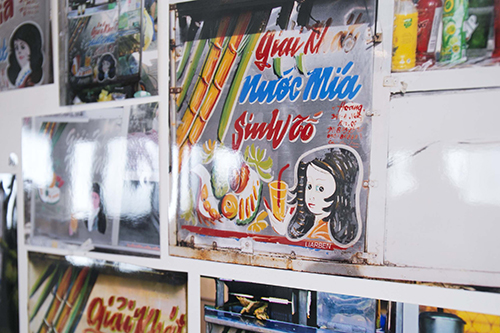
An example of a Sugarcane Lady
- What exactly does the "Sugarcane Lady Project" involve?
We collect photographic documents of actual Sugar Cane Ladies and stories about them.
I actually wanted to find out who was the first person to draw this woman, but the people who were alive at the time are all old, so it was difficult to talk to them. So instead, I decided to use Facebook and other platforms to ask people of that generation, "What is your image of a Sugarcane Lady?" and collect their stories about the Sugarcane Lady.
- So your research subjects were people who were alive around the 1970s when the Sugarcane Lady was painted. How long have you been working on this project and how many people have responded to you?
It's been about a year since we started this project, and we've had 10 people answer our questions and tell us their stories.
During the research, we came across the Vietnamese national singer Thanh Lang - what is her connection to Japan?
- What kind of story did you have?
For example, "This Sugar Cane Lady was the daughter of an American general and she was so beautiful that she couldn't be Vietnamese," or "She eventually married a French officer and moved from the countryside to the city."
Among them, the story of Phan Thai Thanh Lang, a singer active from 1960 to 1975, is an interesting one that is also relevant to Japan. As I was conducting research, someone sent me a photo of this national singer. When I saw it, I realized that the image of the Sugarcane Lady and Thanh Lang was very close to the ideal image of a woman for Vietnamese people. So now I am exploring the connection.
- She was a singer during the Vietnam War. What is she doing now?
And what is its relationship with Japan?
She defected to the United States and is now in the United States. (Note: Thanh Lang was the No. 1 actress and diva in Vietnam at the time. After the war ended, she tried to escape Vietnam as a boat person many times and succeeded in defecting to the United States.)
By the way, this is her song.
- What?! It's in Japanese?!
It is generally said that the friendship between Japan and Vietnam has deepened since the 1990s, but I believe that there was a friendship between them before 1975. This is because Japanese producers went to Vietnam around that time and produced many artists. I think this video is proof of that.
- So a small part of history emerges from one person's personal memories. That's a very interesting story.
What is Ben pursuing through collecting the Sugarcane Lady paintings and the stories surrounding those images? Also, do you have a clear goal for this project at this stage?
Through this project, I am not just pursuing the image of women, but also placing emphasis on collecting historical memory of Vietnam, because it will also be a record of the history of the country where I live.
It's been about a year since I started this project, but I still don't know where it's going to end up. But if I can get to a point where I'm satisfied, or if this project has some positive effect and I can feel that for myself, then I think that might be the goal of this project. At this point, I don't know where the end is.
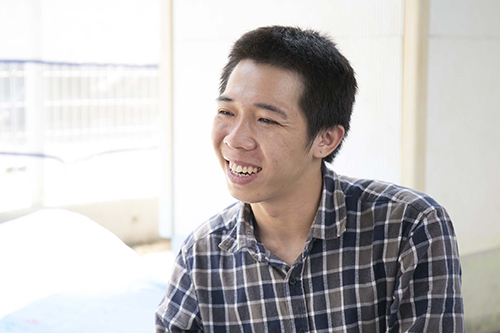
About the works exhibited at Koganecho Bazaar 2014
- At Koganecho Bazaar 2014, you will be able to see the current state of what you have been exploring for the past year. Please tell us more about this exhibition and demonstration.
In Koganecho, I am exhibiting at Studio 1-1 photos of sugarcane juice stalls and various sugarcane ladies that I have collected. Some of the sugarcane ladies I have drawn are also on display. And at Kaidan Square, I am setting up an actual stall and offering sugarcane juice made from sugarcane imported from Okinawa to everyone.
- The food stall was also handmade by Ben. What is the special feature of this food stall?
As you can see in the photos in the exhibition room, there are several variations in the sugarcane juice stalls sold in Vietnam, and among them, Chinese-style stalls incorporate Chinese history into their decorations and talk about their history while selling. I imitated that style this time and painted decorations on my stall that show Vietnamese history and culture.

If you spot Ben at Kaidan Square, be sure to say hello and try his sugarcane juice. Sugarcane juice is much more refreshing than you might imagine, with a taste a bit like watermelon juice, perfect for the summer.
And this time, as part of the Koganecho Bazaar, Ben held a mural painting workshop with the children of Keikyu Kids Land Koganecho. You can see the scene here. By the way, the paintings that were painted here will be exhibited on the steel plate in front of "Bazaar Bazaar".

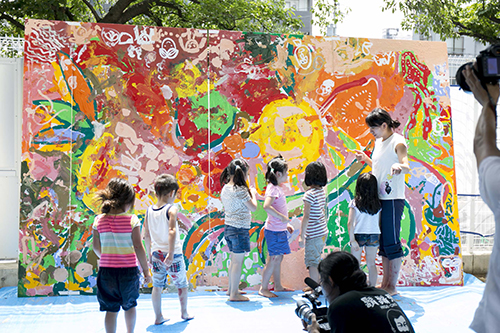
Ryer Ben as a street artist
Finally, for this article, we were kindly asked to send some photos of Ben's work as a street artist. Be sure to check out another side of Ryer Ben!
